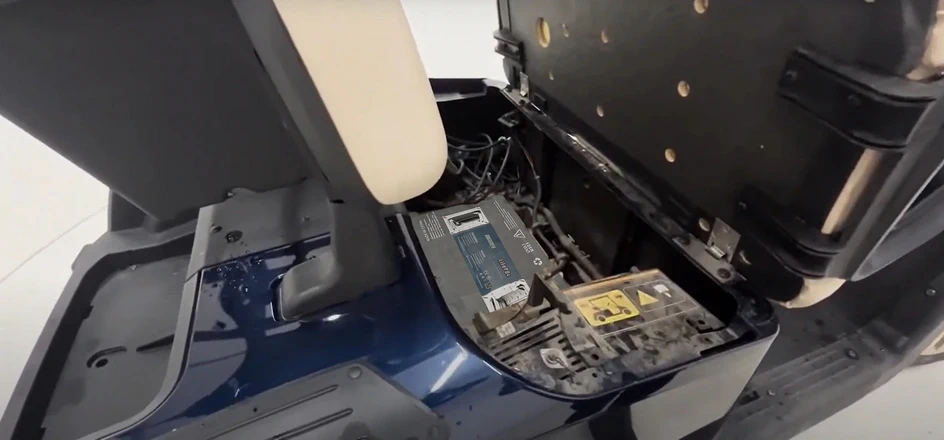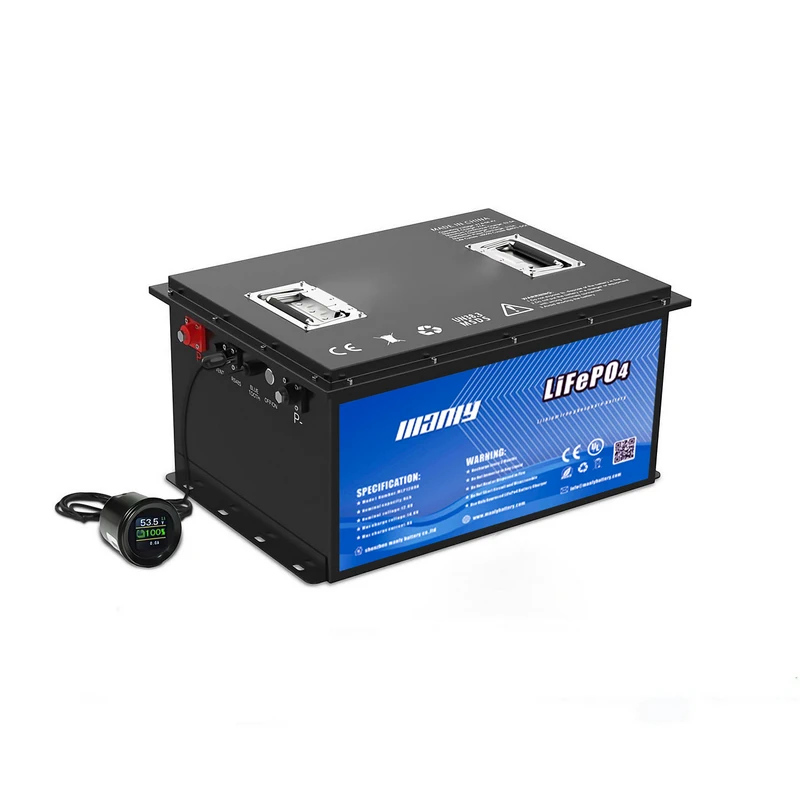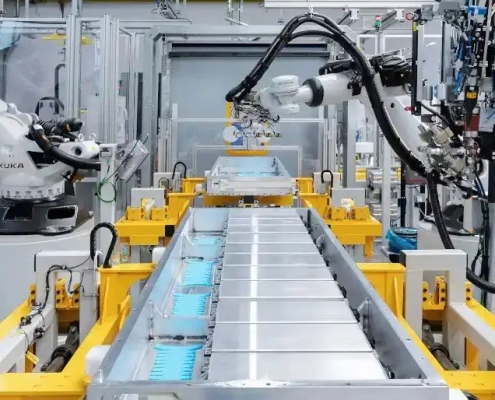2024 Can You Use Lithium Batteries in Any Golf Cart?
Table of Contents
- 2024 Can You Use Lithium Batteries in Any Golf Cart?
- Essential Tools for Upgrading to Lithium Batteries
- Converting Your Golf Cart to Lithium Batteries
- Determining the Right Battery Size for Your Cart
- How to Properly Charge a Lithium Battery
- Do You Need Battery Spacers?
- Why Switch from Lead-Acid to Lithium Batteries?
- Critical Considerations for Switching to Lithium Batteries
- Converting an EZ GO Golf Cart to Lithium Batteries
- Cost Considerations for Converting to Lithium Batteries
- Maintaining and Caring for Your Lithium Golf Cart Battery
- Comparing Lead-Acid to Lithium Batteries: Why Make the Switch?
- Cost Considerations: Upfront vs. Long-Term Savings
- Final Thoughts on Switching to Lithium Batteries
- Learn More About Battery
Many golf cart owners are switching to lithium batteries for golf cart systems. The question on most minds is whether installing these batteries in any golf cart is possible. The simple answer is yes, but several key factors must be considered to ensure compatibility and performance. This article breaks down the process of converting a golf cart to lithium batteries and highlights the benefits of doing so.

Essential Tools for Upgrading to Lithium Batteries
Switching to lithium battery for golf cart systems involves more than just swapping out the old batteries. Here’s what you’ll need to complete the upgrade:
- Select the Appropriate Battery: Choosing lithium batteries that match your golf cart’s power system is essential. This means a 48V lithium battery setup for most carts, although some may use different voltages.
- Invest in a Compatible Charger: Lithium batteries have charging requirements different from those of traditional lead-acid batteries. Please make sure you have a charger built for lithium batteries to avoid potential damage.
- Install a Battery Management System (BMS): A BMS helps protect the battery by monitoring its charge cycles, preventing overcharging, and ensuring optimal performance.
Converting Your Golf Cart to Lithium Batteries
Upgrading your golf cart to golf cart lithium batteries is a relatively straightforward process if you have the right tools. Start by removing the old lead-acid batteries, which are typically heavy and require careful handling. Afterward, you’ll install the new lithium batteries, which often fit directly into the existing battery compartment without significant adjustments.
Once in place, the lithium batteries will significantly reduce the golf cart’s overall weight, improving maneuverability and reducing wear and tear on components like brakes and tires. Additionally, the lighter weight contributes to better energy efficiency, meaning fewer charges will be required during regular use.
Determining the Right Battery Size for Your Cart
Choosing the correct lithium battery for golf cart depends on your cart’s voltage needs and your desired range. Most golf carts run on a 48V system, but the number of batteries required will depend on how far you typically travel. For instance, installing two 48V lithium batteries might give you a range of 20-30 miles, while adding more batteries can extend that distance.
It’s also important to consider the battery’s amp-hour (Ah) rating. Higher Ah ratings provide more power between charges, which may benefit those who use their cart for longer trips. However, higher capacities can also raise the overall cost of the system.
How to Properly Charge a Lithium Battery
Remember to fully charge your golf cart’s newly installed lithium battery to optimize performance and extend its lifespan. Unlike traditional lead-acid batteries, lithium batteries require a unique charging approach. Here’s how to ensure proper charging:
- Use a Compatible Charger: Standard chargers for lead-acid batteries are unsuitable for lithium batteries. You’ll need a charger specifically designed for golf carts lithium batteries to match their voltage and charging requirements.
- Benefit from Faster Charging: One key advantage of lithium batteries is their charging speed. Lithium batteries typically recharge in just a few hours, unlike lead-acid batteries, which can take up to 8 hours or more.
- Avoid Overcharging Risks: Most lithium battery for golf cart systems include a built-in Battery Management System (BMS), which helps regulate the charging process. This feature ensures the battery won’t overcharge, reducing risks like overheating or battery damage.
Selecting the correct charger and following these best practices’ll keep your lithium batteries running efficiently and extend their lifespan.
Do You Need Battery Spacers?
Lithium batteries are often more compact and lighter than the lead-acid batteries they replace. Because of this, you might find extra room in your cart’s battery compartment. In such cases, battery spacers help secure the golf carts lithium batteries.
Spacers are small, durable devices that fill the space, keeping the batteries from shifting while you drive. This is especially useful if you frequently use your cart on uneven ground. Additionally, battery spacers allow you to reuse the original battery holders, which makes the installation process more manageable.
Why Switch from Lead-Acid to Lithium Batteries?
Making the switch to golf carts lithium batteries is a smart move for several reasons:
- Reduced Weight: Lithium batteries are much lighter than traditional lead-acid batteries. This lighter weight results in improved handling and better energy efficiency.
- Minimal Maintenance: Lead-acid batteries require routine maintenance, such as topping off water levels. In contrast, lithium batteries are nearly maintenance-free.
- Faster Charging and Longer Life: Lithium batteries charge more quickly than their lead-acid counterparts and hold a charge longer, reducing the need for frequent recharging.
- Longer Lifespan: Lead-acid batteries typically last 3 to 5 years. On the other hand, lithium battery for golf cart systems can last up to a decade, offering great value in the long run.
Switching to lithium will save you time and hassle while enhancing your golf cart’s performance.
Critical Considerations for Switching to Lithium Batteries
Before you decide to upgrade to golf carts lithium batteries, consider these critical factors:
- Upfront Cost: Lithium batteries can be more expensive than lead-acid alternatives. However, their long lifespan and lower maintenance needs can save you money.
- System Compatibility: Ensure your golf cart’s electrical components are compatible with lithium batteries. Minor modifications, such as upgrading the controller, may sometimes be necessary.
- Power Requirements: Depending on how you use your golf cart, you might need more or fewer batteries. If you often drive long distances or over challenging terrain, you may want to add additional batteries for extended range.
Converting an EZ GO Golf Cart to Lithium Batteries
Upgrading your EZ GO golf cart to golf cart lithium batteries is a straightforward process that can significantly enhance performance. While it does require attention to detail, the conversion is well within the capabilities of most owners. Lithium batteries bring several advantages, including faster charging times, longer battery life, and less maintenance. Below is a comprehensive guide tailored to help you through the conversion process for EZ GO carts.
Step 1: Assess the Current Battery Setup
Before you begin the conversion, could you take a moment to see the current battery configuration in your EZ-GO cart? Most EZ-GO models come equipped with six lead-acid batteries, often 8 volts each, wired in series to create a total of 48 volts. If your cart operates on a 36-volt system, you will likely find six 6-volt batteries. Understanding the configuration will help you choose the appropriate lithium battery for golf cart conversion.
Step 2: Select the Right Lithium Battery
The type of lithium battery you need will depend on your cart’s voltage. For a 48V system, you will need a corresponding 48V lithium battery setup. Lithium batteries come in various form factors and energy storage capacities, providing flexibility to select the most appropriate option based on specific usage needs. For instance, two 48V lithium batteries might suffice for daily use, offering around 20-30 miles per charge. You can add more batteries for extended driving ranges, increasing your range to 40-50 miles or more.
Step 3: Safely Remove Lead-Acid Batteries
The next step involves safely removing the existing lead-acid batteries. These batteries are not only heavy, weighing more than 50 pounds each, but they also contain acid that can be hazardous. Use gloves and proceed carefully to avoid any spills or leaks. Proper disposal of these batteries is essential, as they are classified as hazardous waste. Take your time to remove all six batteries to avoid damaging other cart parts, ensuring your safety and the safety of your surroundings.
Step 4: Clean the Battery Compartment
With the lead-acid batteries removed, cleaning the battery compartment thoroughly is essential. If cleaned properly, acid residue or corrosion may be removed, which could affect the new lithium batteries. A solution of sodium bicarbonate and water is effective for neutralizing acid and eliminating indications of corrosion. Ensure the tray and battery terminals are completely clean before installing the golf carts’ lithium batteries, giving you the confidence that your new setup is in top condition.
Step 5: Install the New Lithium Batteries
You’re now ready to install your lithium batteries. Lithium batteries offer a substantially higher energy density and lower weight compared to lead-acid batteries, resulting in a more spacious compartment. To prevent the batteries from shifting during use, it’s a good idea to use battery spacers. These help keep the batteries secure, especially when driving on rough or uneven terrain. In most cases, lithium batteries will fit into the existing battery tray without requiring any significant modifications.
Step 6: Wiring and Connections
Once the batteries are securely in place, it’s time to wire them correctly. Your lithium battery kit should come with a detailed wiring diagram. Follow the instructions carefully to connect the batteries in either parallel or series, depending on your cart’s voltage system. Double-check that all positive and negative terminals are connected properly to avoid issues such as short circuits. If your kit includes a Battery Management System (BMS), install it. A BMS is a crucial component that helps monitor battery performance, balance the charge among the cells, and ensure safety by preventing overcharging or discharging.
Step 7: Install the Lithium-Compatible Charger
Please note that lithium batteries require a distinct charger compared to other types of batteries. If your EZ GO’s charger is designed for lead-acid, it won’t be compatible with your new golf carts lithium batteries. You’ll need to install a lithium-compatible charger that matches the specifications of your new battery setup. Modern lithium chargers are “smart” chargers designed to optimize the charging process and prevent overcharging. If you prefer convenience, you can install the charger onboard, making it easier to charge your cart anywhere.
Step 8: Test the System
With the installation complete, it’s time to test the new setup. Ensure all wiring connections are secure and the charger is correctly installed. Take your cart for a short test drive to verify that the batteries provide the expected power. If you encounter any issues such as a sudden loss of power or the cart not responding as expected, refer to the troubleshooting guide provided with your lithium battery kit. After the conversion, the cart should feel lighter and more responsive due to the reduced weight of the lithium batteries. You’ll likely notice improvements in acceleration and range compared to your previous lead-acid system.
Step 9: Make Additional Adjustments if Needed
Following the conversion, consider making a few additional adjustments to enhance performance. If you regularly drive long distances or navigate hilly terrain, adding extra lithium batteries could help extend your range. Additionally, it’s wise to monitor the battery charge levels. Unlike lead-acid batteries, which gradually lose power, lithium batteries maintain a steady output until the charge is nearly depleted. Consider installing a voltage meter or battery monitoring system to avoid running out of power unexpectedly.
Cost Considerations for Converting to Lithium Batteries
Converting your golf cart to lithium battery for golf cart power is an investment that offers long-term benefits. However, it’s essential to understand the upfront costs involved. While lithium batteries are generally more expensive than lead-acid options, they provide extended lifespan, faster charging, and less maintenance. Here’s a breakdown of typical costs associated with the conversion:
- Battery Costs: Depending on the brand and capacity, quality lithium batteries for golf carts typically range from $1,500 to $3,000. While this cost is higher than lead-acid batteries (which range from $900 to $1,300), lithium batteries’ longer life and better performance make them a worthwhile investment.
- Installation Costs: If you feel confident enough to handle the conversion independently, you can save money on labor. However, professional installation may cost between $500 and $1,000, depending on the complexity of the conversion and the region.
- Charger Costs: Lithium batteries require a special charger, typically costing between $300 and $600. The correct charger ensures your lithium batteries charge safely and efficiently.
Although the initial expense may seem high, many golf cart owners find that the benefits of golf carts lithium batteries—such as reduced maintenance, faster charging, and a longer lifespan—more than justify the investment over time.
Maintaining and Caring for Your Lithium Golf Cart Battery
After converting to a lithium battery for golf cart power, it’s essential to take proper care of your new batteries to ensure they last as long as possible. Lithium batteries are known for their durability and low maintenance needs, but you should follow a few best practices to get the most out of your investment.
Regular Charging Routine
One of the significant advantages of lithium batteries for golf carts is their charge efficiency. However, keeping them charged regularly is critical to maintaining their health. While lead-acid batteries must be charged frequently to prevent sulfation, lithium batteries do not suffer from this issue. This means you don’t need to worry about leaving the cart unused for a few weeks, as lithium batteries will retain their charge over time. Ensure you don’t completely drain the battery before recharging, which can impact its long-term health.
Use the Right Charger
As previously mentioned, lithium batteries require a specific charger. Always use the charger recommended by the manufacturer, as using an incompatible charger can lead to inefficiencies or even damage to the battery. Many lithium chargers have advanced features like automatic shut-off when the battery is fully charged, helping you avoid overcharging and prolonging battery life.
Monitor Battery Performance
Installing a battery monitoring system or voltage meter to monitor your battery’s performance is a good idea. Lithium batteries behave differently from lead-acid batteries, maintaining total power output until nearly depleted. This means your cart will continue to run at total capacity until the battery is almost empty, and then it will quickly lose power. By monitoring the battery’s charge, you can avoid unexpected shutdowns and ensure your cart is always ready.
Store Batteries Properly
If you need to store your golf cart for an extended period, it’s essential to store the lithium battery for golf cart correctly. Unlike lead-acid batteries, which require a trickle charge during long storage periods, lithium batteries can hold their charge for months without issue. For optimal storage, ensure the battery is charged to around 50% and disconnect it from the cart’s electrical system. Please store the batteries in a location with consistent, moderate temperature and low humidity to prevent degradation caused by extreme temperature fluctuations, thus ensuring optimal lifespan.
Inspect for Wear and Tear
Golf cart lithium batteries are engineered for longevity, but regular inspections for wear and damage are advisable. Check for loose connections, corrosion around the terminals, or physical damage to the battery casing. Catching issues early can prevent more significant problems and ensure the battery remains in peak condition for as long as possible.
Comparing Lead-Acid to Lithium Batteries: Why Make the Switch?
The decision to replace your golf cart’s lead-acid batteries with golf cart lithium batteries can offer a wide range of benefits, particularly in performance, maintenance, and longevity. Below is a comparison of these two battery types to help you understand why the switch to lithium is a smart move for most golf cart owners.
Weight Reduction
One of the most immediate advantages you’ll notice when switching from lead-acid to lithium battery for golf cart systems is the weight difference. Lead-acid batteries are much heavier, often weighing over 300 pounds for a complete set. In contrast, lithium batteries are significantly lighter, reducing the total weight by over half. This weight reduction makes the cart easier to maneuver and improves energy efficiency, allowing the cart to run longer on a single charge.
Minimal Maintenance
Lead-acid batteries necessitate regular maintenance, including monitoring electrolyte levels and ensuring optimal terminal conditions to prevent corrosion. In contrast, golf carts lithium batteries are virtually maintenance-free. Once installed, they don’t require the same level of attention, saving you time and reducing the likelihood of battery-related issues . This convenience is why many golf cart owners opt for lithium battery systems.
Faster Charging and Longer Life
Lithium batteries charge much more quickly than lead-acid batteries. While lead-acid batteries may take up to 8 hours to fully charge, lithium battery for golf cart systems can be fully charged in just a few hours. Rapid charging ensures your golf cart is always ready to go when needed, with less downtime. Additionally, lithium batteries maintain their performance over more charging cycles, often lasting up to 10 years, while lead-acid batteries typically require replacement every 3 to 5 years.
Consistent Power Output
One of the key differences between these two battery types is how they deliver power. Lead-acid batteries gradually lose energy as they drain, which results in your golf cart slowing down or losing performance as the battery nears empty. On the other hand, golf carts lithium batteries provide consistent power output throughout their charge cycle. This means your cart will continue to operate at peak performance until the battery is nearly depleted, offering a smoother and more reliable ride.
Cost Considerations: Upfront vs. Long-Term Savings
Understanding the costs involved when switching to lithium battery for golf cart systems is essential. While lithium batteries are typically more expensive upfront, but they offer significant long-term savings in maintenance, lifespan, and energy efficiency.
Initial Investment
Lithium batteries usually cost between $1,500 and $3,000, depending on the capacity and brand. This price is higher than lead-acid batteries, ranging from $900 to $1,300. However, lithium batteries last considerably longer, often doubling or tripling the lifespan of lead-acid batteries. Over time, the lower frequency of replacements and reduced maintenance make lithium a more cost-effective choice.
Lower Maintenance Costs
With golf cart lithium batteries, there’s no need to spend time or money on regular maintenance tasks like topping off water levels or cleaning corrosion. The higher upfront cost of this technology can be offset by hundreds of dollars in savings over the battery’s lifetime, making it a more manageable investment in the long term.
Long-Term Efficiency
Lithium batteries are more efficient when it comes to energy use and provide more consistent performance. Because they can hold a charge for longer periods and charge more quickly, you’ll need fewer charges overall, saving on energy costs. This translates into long-term savings and better performance over the battery’s life.
Final Thoughts on Switching to Lithium Batteries
Converting your golf cart to lithium batteries is a decision that can drastically enhance your cart’s overall performance and reduce the amount of maintenance required. While the initial investment may seem high compared to traditional lead-acid batteries, the long-term benefits outweigh the costs. Lithium batteries are an intelligent upgrade for any golf cart owner, from quicker charging times to improved efficiency and a much longer lifespan.
Environmental Impact
Beyond performance and cost, switching to lithium battery for golf cart systems also has environmental advantages. Lead-acid batteries contain harmful chemicals that must be carefully disposed of to avoid environmental contamination. Lithium batteries, conversely, are more eco-friendly due to their longer lifespan, meaning fewer batteries end up in landfills over time. Lithium batteries provide a sustainable alternative for individuals looking to reduce their environmental footprint.
Performance on Different Terrains
Another key benefit of switching to lithium is the improved handling and performance, especially on varied terrains. The lighter weight of golf carts lithium batteries means your cart will respond better on hills, rough terrain, or uneven surfaces. Whether you’re navigating a golf course, a neighborhood, or a hilly area, lithium batteries ensure smoother and more reliable operation throughout the day.
Longer Lifespan for Your Cart
By reducing the weight load on your golf cart and providing consistent power, lithium battery for golf cart setups extend the overall lifespan of the vehicle itself. The reduced strain on the cart’s mechanical components, such as brakes and tires, means these parts won’t wear out as quickly. In the long run, this adds to the overall value of your investment, as both the cart and the batteries will last longer with fewer repairs needed.
Key Takeaways
If you’re considering upgrading your golf cart to golf carts lithium batteries, it’s clear that the benefits go beyond just performance improvements. You’re investing in a system that provides:
- Consistent power throughout the battery’s charge cycle.
- Reduced weight, improving handling and efficiency.
- Faster charging times ensure your cart is ready for use quickly.
- Low maintenance, saving you both time and money.
- Longer lifespan, potentially lasting twice as long as traditional lead-acid batteries.
While the initial cost of conversion may be higher, the long-term savings in maintenance, fewer replacements, and improved performance make lithium batteries a superior choice for golf cart owners who value reliability, efficiency, and sustainability.






